Kappa is a family of solid-fuel Japanese sounding rockets, which were built starting from 1956.
Kappa is a family of solid-fuel Japanese sounding rockets, which were built starting from 1956.
The Rikugun Ki-202 Shūsui-Kai was a direct development of the German Messerschmitt Me 163 Komet rocket-powered interceptor aircraft. None were produced before Japan's surrender that ended World War II.

The Black Brant is a family of Canadian-designed sounding rockets originally built by Bristol Aerospace, since absorbed by Magellan Aerospace in Winnipeg, Manitoba. Over 800 Black Brants of various versions have been launched since they were first produced in 1961, and the type remains one of the most popular sounding rockets. They have been repeatedly used by the Canadian Space Agency and NASA.

The Sikorsky Cypher and Cypher II are types of unmanned aerial vehicles developed by Sikorsky Aircraft. They are vertical takeoff and landing aircraft which use two opposing rotors enclosed in a circular shroud for propulsion.

The Bell X-9 Shrike was a prototype surface-to-air, liquid-fueled guided missile designed by Bell Aircraft as a testbed for the nuclear-armed GAM-63 RASCAL. It is named after the shrike, a family of birds.
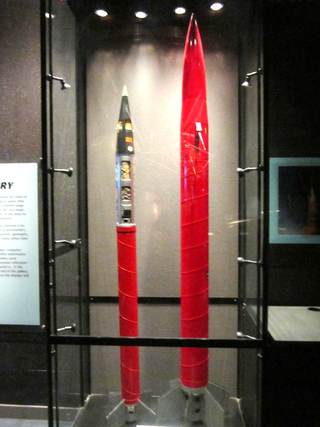
Skua is the designation of a British sounding rocket which was launched between 1959 and 1981 in 4 versions over 300 times. The Skua was developed by Bristol Aerojet and RPE Wescott. It consisted of a starting stage made up of several Chick rockets that burned for 0.2 seconds. They propelled the rocket 20 metres over the 5-metre-long launch tube. After that, the Bantam main stage ignited.
Bélier is the designation of a single-stage French sounding rocket. Three versions of the Bélier were launched between 1961 and 1970 at the CIEES launch facility at Hammaguir, the Salto di Quirra and Ile de Levant missile ranges, and Kourou Space Center. After its retirement, the Bélier was used as an upper stage of other French sounding rockets, including the Dragon.
The INTA-255 was a Spanish sounding rocket.
Taurus Orion is the designation of a two-stage sounding rocket, consisting of a Taurus starting stage and an Orion upper stage. The Taurus Orion has a ceiling of 200 km, a takeoff thrust of 457.00 kN, a takeoff weight of 2000 kg, a diameter of 0.58 m and a length of 11.40 m.
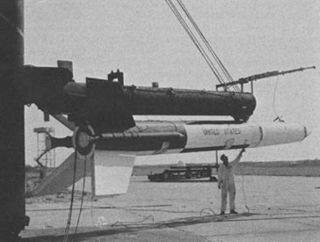
Astrobee is the designation of series of American sounding rockets with 1 - 3 stages.
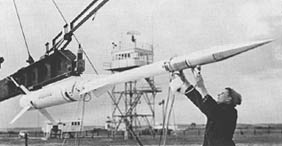
Nike Asp was an American sounding rocket. The Nike Asp has a ceiling of 220 km, a takeoff thrust of 217 kN, a takeoff weight of 700 kg, a diameter of 0.42 m and a length of 7.90 m.
Deacon is the designation of an American sounding rocket. The Deacon was launched 90 times from 1947 to 1957 from Wallops Island, and it also was the rocket portion of the first rockoons, launched 1952 to 1956. The Deacon has a maximum flight height of 20 kilometers and a pay load ability of 17 kilograms. The takeoff thrust of the Deacon amounts to 27 kN, the takeoff weight 93 kg, the diameter 0.16 m and the length 3.28 m.
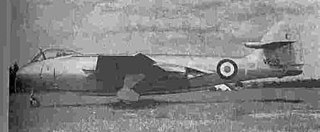
The Hawker P.1072 was a 1949 experimental British aircraft acting as a test bed for the Armstrong Siddeley Snarler rocket booster engine. It was the prototype Hawker Sea Hawk modified to install the rocket in the tail.

The Hughes XH-17 "Flying Crane" was the first helicopter project for the helicopter division of Hughes Aircraft Company. The XH-17, which had a two-bladed main rotor system with a diameter of 134 feet, still holds the world record for flying with the largest rotor system. It was capable of flying at a gross weight of more than 50,000 pounds (23,000 kg), but proved too inefficient and cumbersome to be mass-produced beyond the prototype unit.

Sonda is a family of Brazilian-built sounding rockets which serves as an R&D path to the VLS orbital rocket. Launches started in 1965 and continue to this day. Launch sites include Wallops Island, Andoya, Kiruna, Natal, Alcântara, Cassino and SvalRak.
Valmet L-80 TP Turbo-Vinha was a prototype for a new Finnish turboprop basic trainer aircraft. The aircraft, which carried the designation OH-VBB, first flew on 12 February 1985. It was destroyed in a crash on 24 April 1985, during its 14th flight, killing the test pilot Paavo Janhunen. The aircraft was a further development of the Valmet L-70 Vinka and would eventually lead to the Valmet L-90 Redigo.

VSB-30 - "Veículo de Sondagem Booster – 30" or "Foguete Suborbital VSB-30" is the designation of a Brazilian sounding rocket, which replaced the Skylark rocket at Esrange.

The Gotha Go 150 was a light aircraft designed at the German company Gothaer Waggonfabrik in the late 1930s. It was intended for civilian use, but ended up being used as a military trainer.
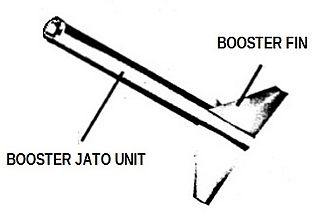
The Nike stage or Nike booster, a solid fuel rocket motor, was created by Hercules Aerospace for the Nike Ajax (M5) Nike Hercules (M5E1). It was developed for use as the first stage of the Nike Ajax and Nike Hercules missiles as part of Project Nike.
The Deland Travel Air 2000 is an American homebuilt aircraft that was designed and produced by Orlando Helicopter Airways, an aircraft maintenance and repair company located in DeLand, Florida. When it was available the aircraft was supplied as a kit for amateur construction and marketed under the "Deland" brand, named for the company's location. Plans were also available.

The Algol family of solid-fuel rocket stages and boosters is built by Aerojet and used on a variety of launch vehicles. It was developed by Aerojet from the earlier Jupiter Senior and the Navy Polaris programs. Upgrades to the Algol motor occurred from 1960 until the retirement of the Scout launch vehicle in 1994.